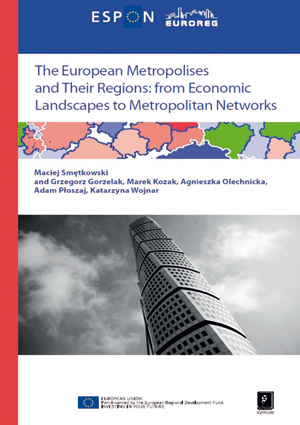
The European Metropolises and their regions: from Economic Landscape to Metropolitan Networks
This publication summarises selected findings from the project entitled Future Orientation of Cities (FOCI), which was completed as part of the ESPON 2007-2013 Programme, and looked at the relationships between European metropolises and their surrounding regions. The research on the linkages between cities and their hinterlands was inspired by the European Spatial Development Perspective – ESDP (1999) which, amongst its proposed activities, highlighted the need to develop a partnership between cities and rural areas. This stance informed a number of research projects such as PLUREL, funded as part of the 6th Framework Programme, or EDORA within the ESPON 2007-2013 programme. Nonetheless, the studies discussed in this publication basically leave aside the dichotomous division into cities and rural areas analysed in the aforementioned projects, and instead focus on the division into metropolitan areas and their regional surroundings, which seems to more accurately address the economic realities of the present day.
This dimension of differences between metropolitan regions was investigated in earlier studies conducted by the Centre for European Regional and Local Studies (EUROREG) at the University of Warsaw by the team of Grzegorz Gorzelak and Maciej Smętkowski. The results of these studies were published in a book entitled The metropolis and its region: New relationships in the information economy [in Polish] and in a number of papers, including those in the journal European Planning Studies. It should be pointed out, however, that the empirical analyses underpinning those studies were based on three metropolitan regions situated in Poland. The papers submitted in this publication cover the majority of metropolitan macroregions across Europe, and analyse fi ve of them in depth (Barcelona, Glasgow, Stockholm, Toulouse and Warsaw) due to their distinctive characteristics in terms of the relationships that occur between these cities and their surroundings. The fundamental research hypothesis assumed that the disparities in the development level between metropolises and their regions will increase owing to a relative weakening of their mutual ties as a result of a dynamicdevelopment of linkages existing within the global network of big cities.
In an attempt to indirectly verify this, we set out to evaluate – using multivariate quantitative methods – the growth dynamics of metropolises and their regions while simultaneously taking account of the differences in their economic structures, labour market situations as well as ongoing demographic changes. The relationships between the metropolis and the region were directly analysed via in-depth case studies, including questionnaire surveys of both enterprises and the local authorities, as well as interviews with major regional development actors. As a result, a typology of European metropolitan macroregions has been developed, with some conclusions relating to their scale and the underlying factors, as well as potential scenarios on how metropolitan systems in Europe may evolve in the future.
We would like to emphasise that this book encapsulates only a small part of the research done as part of the ESPON FOCI project. The remaining analyses which address such issues as the competitiveness of cities (including their economic, transport and research linkages), the coherence of cities (including ongoing segregation processes), and the sustainabilityof urban development, particularly in the context of urban sprawl, can be found in the final project report available on the website: www.espon.eu.




